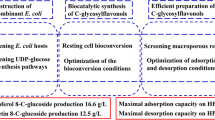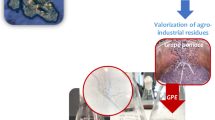Abstract
Rhizopus microsporus isolated by our laboratory was able to transform polydatin into resveratrol and emodin-8-β-d-glucoside into emodin, respectively, through the fermentation of Polygonum cuspidatum Sieb. et Zucc. The fermentation products were separated and purified by H1020 resin and silica gel column chromatography. Thin layer chromatography (TLC) and high performance liquid chromatography (HPLC) were used to identify the products and evaluate the transformation efficiency. A variety of parameters of submerged state fermentation, including the growth characteristics, the change of β-glucosidase activity and the amount of polydatin, resveratrol, emodin-8-β-d-glucoside, emodin, and the dissolved oxygen, were monitored simultaneously. The amount of resveratrol yielded increased dramatically from 0.04 g/l at the beginning to the maximum value of 0.34 g/l at 36 h of fermentation, and emodin was from 0.4 g/l to 0.65 g/l at 80 h. The transformation rate of glycosides reached 98% and the purity of both resveratrol and emodin was 95%.






Similar content being viewed by others
References
Alejandro M, Roser R, Ramon C, Isidre C (2002) Comparison of the Kjeldahl method and a combustion method for total nitrogen determination in animal feed. Talanta 57:1019–1026
Chen L, Han Y, Yang F, Zhang T (2001) High-speed counter-current chromatography separation and purification of resveratrol and piceid from Polygonum cuspidatum. Journal of Chromatography A 907:343–346
Choi Y, Kim K, Rhee JS (2002) Hydrolysis of soybean isoflavone glucosides by lactic acid bacteria. Biotechnol Lett 24:2113–2116
Chu X, Sun AL, Liu RM (2005) Preparative isolation and purification of five compounds from the Chinese medicinal herb Polygonum cuspidatum Sieb. et Zucc, by high-speed counter-current. Chromatography. 1097:33–39
Frémont L (2000) Biological effects of resveratrol. Life. Sci. 66:663–667
Helrich K (1990) Official methods of analysis of the association of official analytical chemists, 15th edn. Association of Official Analytical Chemists Inc., Arlington, p 807
Jeandet P, Breuil AC, Adrian M, Weston LA, Debord S, Meunier P, Maume G, Bessis RJ (1997) HPLC analysis of grapevine phytoalexins coupling photodiode array detection and fluorometry. Anal Chem 69:5172–5177
La Torre GL, Lagana G, Bellocco E, Vilasi F, Salvo F, Dugo G (2004) Improvement on enzymatic hydrolysis of resveratrol glucosides in wine. Food Chem 85:259–266
Li YQ (1999) Processing of herbs which contain glycosides. Henan J Tradit Chin Med Pharm 14 (5):18–19
Man RL, Ni WD, Jia HT, Lin J, Li ZM, Li B, Lu HM (2005) Determination of stilbene and anthroquinone compound in polygonum cuspidatum Sieb et Zucc by spectrophotometric method. Chin J Anal Chem 33:1808–1808
Matsuda H, Shimoda H, Morikawa T, Yoshikawa M (2001) Phytoestrogens from the Roots of Polygonum cuspidatum (Polygonaceae): Structure-Requirement of Hydroxyanthraquinones for Estrogenic Activity. Bioorg Med Chem Lett 11:1839–1842
Niu PQ, Guo CY (2006) Investigative development of pharmacology of resveratrol. Herald Med 6 (6):524–525
Rommel A, Wrolstad RE (1993) Influence of acid and base hydrolysis on the phenolic composition of red raspberry juice. J Agr Food Chem 41:1237–1241
Tang XB, Wu JE, Zhao XY (2000) Determination of Emodin in Polygonum cuspidatum by HPLC. Prim J Chin Mater Med 14 (4):17–18
Yu S, Olsen CE, Marcussen J (1998) Methods for the assay of 1,5-anhydro-d-fructose and α-1,4-glucan lyase. Carbohyd Res 305:73–82
Zhao RZ, Liu SJ, Zhou LL (2005) Rapid quantitative HPTLC analysis, on one plate, of emodin, resveratrol, and polydatin in the chinese herb Polygonum cuspidatum. Chromatographia 61:311–314
Zhang CN, Zhang XZ, Zhang Y, Xu Q, Xiao HB, Liang XM (2006) Analysis of estrogenic compounds in Polygonum cuspidatum by bioassay and high performance liquid chromatography. J Ethnopharmacol 105:223–228
Acknowledgement
This study was Chinese patent item (patent number: 200510020761.4). The authors express gratitude to Professor Wen-quan Zou and Mr Xingyu Zhang for their technical assistance on product isolation.
Author information
Authors and Affiliations
Corresponding author
Rights and permissions
About this article
Cite this article
Tian, T., Sun, Q., Shen, J. et al. Microbial transformation of polydatin and emodin-8-β-d-glucoside of Polygonum cuspidatum Sieb. et Zucc into resveratrol and emodin respectively by Rhizopus microsporus . World J Microbiol Biotechnol 24, 861–866 (2008). https://doi.org/10.1007/s11274-007-9551-z
Received:
Accepted:
Published:
Issue Date:
DOI: https://doi.org/10.1007/s11274-007-9551-z




